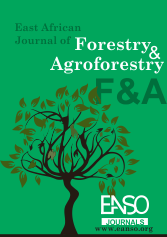The Influence of Anthropogenic Activities on Forest Cover Change in Mbiwe Forest Reserve, Chunya District, Tanzania
Abstract
Unsustainable land uses resulting from increased anthropogenic activities have led to land use cover change (LUCC), undermining forest resilience by altering ecosystem functions and biodiversity values. This study quantified anthropogenic disturbances and their influence on forest cover change in Mbiwe Forest Reserve, Tanzania, from 2013 to 2024. Dry-season Landsat 8 (2013, 2018) and Landsat 9 (2024) imagery were collected and processed in Google Earth Engine, median composited and classified into closed woodland, open woodland, mining and other land cover using a Random Forest Model, achieving overall accuracies of 82%, 85% and 80% and Kappa values of 0.75, 0.80 and 0.73 for 2013, 2018 and 2024 respectively. Post-classification change detection in QGIS produced net area changes and annual rates of change. Ground-truth data were collected from 50 systematically and purposively established rectangular plots (40 disturbed, 10 undisturbed), where human disturbance was observed, scored, and recorded. Descriptive statistics quantified each activity’s share of total disturbance, and Kruskal–Wallis tests confirmed significant differences between disturbed and undisturbed plots. The study revealed that the open woodland declined from 17,441.5 ha (48.1 %) to 7,812.6 ha (21.5%), closed woodland decreased from 4,642.9 ha (12.8%) to 3,902.5 ha (10.8%), mining expanded to 7,709.0 ha (21.3%) by 2018 before easing to 6,629.5 ha (18.3%), and other land cover rose steadily to 17,921.7 ha (49.4%). Annual open woodland loss rates were –12.6% (2013–2018) and –2.9% (2018–2024), resulting from mining activities, illegal logging, charcoal production, forest fires, agriculture, grazing, and settlement. The study recommends intensifying protection of buffer zones, implementing targeted tree planting of native species to act as a shock absorber, and enforcing land use regulations to curb illegal artisanal mining, logging, and agricultural activities.
Downloads
References
Andrew, S. M., Nyanghura, Q. M., & Mombo, F. M. (2023). Land cover change and utilization of village land forest reserves in Ludewa, Tanzania. Environmental Challenges 10: 100668.
Campbell, B. M., Angelsen, A., Cunningham, A., Katerere, Y., Sitoe, A., & Wunder, S. (2007). Miombo Woodlands–Opportunities and Barriers to Sustainable Forest Management. Center for International Forestry Research, Bogor, Indonesia. 37pp.
Chomba, B. M., Tembo, O., Mutandi, K., Mtongo, C. S., & Makano, A. (2012). Drivers of Deforestation, Identification of Threatened Forests and Forest Co-Benefits Other Than Carbon From REDD+ Implementation in Zambia. Ministry of Lands, Natural Resources and Environmental Protection, Zambia. 97pp.
Daudi, E., Luswaga, H., Mapunda, P., & Nchimbi, H. (2025). The anthropogenic activities in Makere North Forest Reserve in Tanzania and implications to conservation. Global Ecology and Conservation 57: e03387.
Doggart, N., Morgan-Brown, T., Lyimo, E., Mbilinyi, B., Meshack, C. K., Sallu, S. M., & Spracklen, D. V. (2020). Agriculture is the main driver of deforestation in Tanzania. Environmental Research Letters 15(3): 034028.
FAO. (2020). Global Forest Resources Assessment 2020. Food and Agriculture Organization, Rome. 16pp.
Gizachew, B., Shirima, D. D., Rizzi, J., Kukunda, C. B., & Zahabu, E. (2024). Conservation and avoided deforestation: Evidence from protected areas of Tanzania. Forests 15(9): 15-93.
Jebiwott, A., Ogendi, G. M., Makindi, S. M., & Esilaba, M. O. (2020). Forest cover change and its impacts on ecosystem services in Katimok forest reserve, Baringo County, Kenya. In Handbook of climate change resilience (pp. 515-536). Springer, Cham.
Jew, E. K., Dougill, A. J., Sallu, S. M., O’Connell, J., & Benton, T. G. (2016). Miombo woodland under threat: Consequences for tree diversity and carbon storage. Forest Ecology and Management, 361, 144-153.
Kashaigili J. J., Mdemu, M. V., Nduganda, A. R., Mbilinyi, B. P. (2013). Integrated assessment of forest cover changes and above-ground carbon stock in Pugu and Kazimzumbwi Forest Reserves, Tanzania. Advances in Remote Sensing 2: 1 – 9.
Karenget, J. A. S. (2009). Analysis of forest degradation in Miombo Woodlands using remote sensing and GIS: Case study of Kitulangalo Forest in Morogoro, Tanzania (Master's thesis, University of Twente).
Kayombo, C. J., Ndangalasi, H. J., Mligo, C., & Giliba, R. A. (2020). Analysis of land cover changes in Afromontane vegetation of Image Forest Reserve, Southern Highlands of Tanzania. The Scientific World Journal 2020(1): 740 – 2846.
Kilawe, C. J., Mertz, O., Birch-Thomsen, T., & Maliondo, S. M. (2018). Transformation of shifting cultivation: Extent, driving forces and impacts on livelihoods in Tanzania. Applied geography 94: 84 – 94.
Kitereja, S. (2015). Effects of forest cover change on carbon stock in Miombo woodlands: A case of Mbiwe forest reserve in Mbeya region, Tanzania. Dissertation for Award of MSc Degree at Sokoine University of Agriculture, Morogoro, Tanzania. 83pp.
Lupala, Z. J., Lusambo, L. P., Ngaga, Y. M., & Makatta, A. A. (2015). The land use and cover change in miombo woodlands under community-based forest management and its implication to climate change mitigation: a case of southern highlands of Tanzania. International Journal of Forestry Research 2015(1): 459102.
Makero, J. S., & Kashaigili, J. J. (2016). Analysis of land-cover changes and anthropogenic activities in Itigi Thicket, Tanzania. Advances in Remote Sensing 5(04): 269.
Mgalula, M. E., Majule, A. E., Saria, A. E., & Mwakisunga, B. (2024). Land use and land cover changes and their driving forces in selected forest reserves in Central Tanzania. Trees, Forests and People 16: 100-584.
MNRT. (2015). National Forest Resources Monitoring and Assessment of Tanzania Mainland Main Results. Ministry of Natural Resource and Tourism, Dar es Salaam, Tanzania. 124pp.
MNRT. (2019). Status, Ecological Potential and Sustainable Management of Forest Resources in Mainland Tanzania. Ministry of Natural Resource and Tourism, Dar es Salaam, Tanzania. 341pp.
MNRT. (2021). National Forest Policy Implementation Strategy (2021 - 2031). Forest Policy. Ministry of Natural Resource and Tourism, Dar es Salaam, Tanzania. 1–89pp.
Msoma, A. J. A., Nzunda, E. F., Manyanda, B. J., & Ramiya, A. M. (2024). Recovery of forest land due to forest landscape restoration following restriction of mining activities in the northern part of Amani Nature Forest Reserve, Tanga, Tanzania. East African Journal of Forestry and Agroforestry 7(1): 471-487.
NBS. (2022). Administrative Units Population Distribution Report. President’s Office Finance and Planning, Office of the Chief Government Statistician, Tanzania. 290pp.
Nchimbi, G., Moyo, F., & Treydte, A. (2021). Tree species diversity, composition and structure across human impacted and non-impacted areas in upgraded Marang’ Forest, Northern Tanzania. Journal of Biodiversity and Environmental Sciences 19(5): 50–64.
Nguyen, L. B. (2020). Land cover change detection in northwestern Vietnam using Landsat images and Google Earth Engine. Journal of Water and Land Development 46(7): 162–169.
Nkya, S. E., Shirima, D. D., Masolele, R. N., Hedenas, H., & Temu, A. B. (2024). Mapping dominant tree species of miombo woodlands in Western Tanzania using Planet Scope imagery. Discover Applied Sciences 6(10): 528.
Nzunda, E. F. (2021). Conservation policy, type of protected area and deforestation in mainland Tanzania. International Journal National Resource Ecology Management 6(2): 1- 49.
Nzunda, E. F., & Midtgaard, F. (2019). Deforestation and loss of bushland and grassland primarily due to expansion of cultivation in mainland Tanzania (1995–2010). Journal of Sustainable Forestry 38(6): 509-525.
Nzunda, N. G., Munishi, P. K. T., Soka, G. E., & Monjare, J. F. (2013). Influence of socio-economic factors on land use and vegetation cover changes in and around Kagoma forest reserve in Tanzania. Ethiopian Journal of Environmental Studies and Management 6(5): 480-488.
Nzunda, H. P. (2013). Impacts of mining activities on land cover and forest stock in Mbozi district, Mbeya region, Tanzania. Dissertation for Award of MSc Degree at Sokoine University of Agriculture, Morogoro, Tanzania, 111pp.
Ojija, F., & Manyanza, N. M. (2022). Community structure, conservation status, and functional groups of bird species in Mbeya range forests, Tanzania. Journal of Basic & Applied Sciences 18: 33-46.
Pontius Jr, R. G., Shusas, E., & McEachern, M. (2004). Detecting important categorical land changes while accounting for persistence. Agriculture, Ecosystems & Environment 101(2-3): 251-268.
QGIS Development Team. (2023). QGIS Desktop 3.28 User Guide. 1493.
Ramiya, A. M., Nzunda, E. F., & Kilawe, C. J. (2025). Recovery of forest land cover due to forest landscape restoration of the Bunduki gap in the Uluguru Nature Forest Reserve, Morogoro, Tanzania. Arabican Journal Geoscience 18:141.
R CORE TEAM. (2024). An Introduction to R. Practical Graph Mining 1: 27–52.
Rwanga, S. S., & Ndambuki, J. M. (2017). Accuracy assessment of land use/land cover classification using remote sensing and GIS. International Journal of Geosciences8(04): 611–622.
Sanga, F., & Haulle, E. (2024). The paradox of the land use/land cover change in Kipengere ranges in southern highlands of Tanzania. Geology, Ecology, and Landscapes 2024: 1-8.
Yalew, A. W. (2015). The perplex of deforestation in Sub-Saharan Africa. Journal of Tropical Forestry and Environment 5(1): 19–30.
Copyright (c) 2025 Robert Gordon Mwangosi, Japhet Noah Mwambusi, Elifuraha Elisha Njoghomi, Ezekiel Edward Mwakalukwa

This work is licensed under a Creative Commons Attribution 4.0 International License.




























